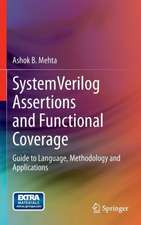Nanotechnology and Neuroscience: Nano-electronic, Photonic and Mechanical Neuronal Interfacing
Editat de Massimo De Vittorio, Luigi Martiradonna, John Assaden Limba Engleză Hardback – 5 mar 2014
| Toate formatele și edițiile | Preț | Express |
|---|---|---|
| Paperback (1) | 540.45 lei 38-44 zile | |
| Springer – 3 sep 2016 | 540.45 lei 38-44 zile | |
| Hardback (1) | 651.51 lei 43-57 zile | |
| Springer – 5 mar 2014 | 651.51 lei 43-57 zile |
Preț: 651.51 lei
Preț vechi: 766.49 lei
-15% Nou
Puncte Express: 977
Preț estimativ în valută:
124.71€ • 135.50$ • 104.82£
124.71€ • 135.50$ • 104.82£
Carte tipărită la comandă
Livrare economică 21 aprilie-05 mai
Preluare comenzi: 021 569.72.76
Specificații
ISBN-13: 9781489980373
ISBN-10: 1489980377
Pagini: 285
Ilustrații: X, 285 p. 139 illus., 101 illus. in color.
Dimensiuni: 155 x 235 x 17 mm
Greutate: 0.73 kg
Ediția:2014
Editura: Springer
Colecția Springer
Locul publicării:New York, NY, United States
ISBN-10: 1489980377
Pagini: 285
Ilustrații: X, 285 p. 139 illus., 101 illus. in color.
Dimensiuni: 155 x 235 x 17 mm
Greutate: 0.73 kg
Ediția:2014
Editura: Springer
Colecția Springer
Locul publicării:New York, NY, United States
Public țintă
ResearchCuprins
Nanotechnology and Neuroscience: nano-electronic, photonic and mechanical neuronal interfacing.- Carbon nanotubes for neuron-electrode interface with improved mechanical performance.- Nanoscale field-effect transistors for minimally invasive, high spatial resolution and three-dimensional action potential recording.- In-cell recording and stimulation by engulfment mechanisms.-Micromachining Techniques for Realization of Three-Dimensional Microelectrode Arrays.- Focused ion beam technology as a fabrication and inspection tool in neuron interfacing.- Active Pixel Sensor Multi Electrode Array for high spatio-temporal resolution.- Multi electrode and multi transistor arrays for in vivo recording.- Optogenetics.
Textul de pe ultima copertă
This book provides an overview of the different ways in which the “nano-world” can be beneficial for neuroscientists. The volume encompasses the latest developments in the field of micro- and nanotechnology applied to neuroscience, discussing technological approaches applied to both in-vitro and in-vivo experiments. A variety of different nanotechnologies are presented that include nanostructured electrodes and their electrical, mechanical and biochemical properties, active and passive 2D and 3D multi-electrode arrays (MEAs), nanoscale transistors for sub-cellular re-cordings and an overview on methods, tools and applications in optoge-netics.
The book focuses specifically on fabrication strategies, to offer a compre-hensive guide for developing and applying micro- and nanostructured tools for neuroscientific applications. It is intended as a reference both for neuroscientists and nanotechnologists on the latest developments in neu-rotechnological tools.
• Provides readers with state-of-the-art information about developing advanced nanotechnology tools for communicating with the brain;
• Includes discussion of the compatibility of fabrication techniques optimized for different target devices, such as electric sensors/transducers based on metallic or semiconductor interfaces and optical probes to guide light into the brain;
• Offers a single-source reference to the mechanical, electrical and optical effects of nanostructures on neurons.
The book focuses specifically on fabrication strategies, to offer a compre-hensive guide for developing and applying micro- and nanostructured tools for neuroscientific applications. It is intended as a reference both for neuroscientists and nanotechnologists on the latest developments in neu-rotechnological tools.
• Provides readers with state-of-the-art information about developing advanced nanotechnology tools for communicating with the brain;
• Includes discussion of the compatibility of fabrication techniques optimized for different target devices, such as electric sensors/transducers based on metallic or semiconductor interfaces and optical probes to guide light into the brain;
• Offers a single-source reference to the mechanical, electrical and optical effects of nanostructures on neurons.
Caracteristici
Provides readers with state-of-the-art information about developing advanced nanotechnology tools for communicating with the brain Includes discussion of the compatibility of fabrication techniques optimized for different target devices, such as electric sensors/transducers based on metallic or semiconductor interfaces and optical probes to guide light into the brain Offers a single-source reference to the mechanical, electrical and optical effects of nanostructures on neurons Includes supplementary material: sn.pub/extras












